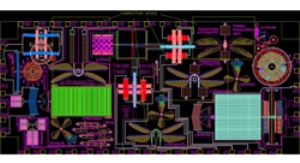Dust-size dragonfly and a high-sensitivity micro-valve won this year’s student design competition for very small equipments at Sandia National Laboratories. Texas Tech University won the contest for its innovative insect and Carnegie Mellon University for the valve.
 Texas Tech students won in the novel design category for their MEMS-based dragonfly design
Texas Tech students won in the novel design category for their MEMS-based dragonfly design
Students demonstrated their micro-electromechanical system (MEMS) designs to the board of engineers at Sandia. All the designs will be fabricated using the laboratory’s advanced fabrication technique known as SUMMiT V, which allows MEMS devices to be manufactured with five layers of polysilicon. The dragonfly can pave the way for new opportunities in the design structure of aerial surveillance equipment. It can be used for measuring radiation leaks from damaged Japanese nuclear reactors for delineation of enemy positions.
Components in advanced micro air equipment vary from 15 cm to less than 1 cm. The dragonfly device is compact and comes equipped with biologically mimetic wings. It measures nearly 0.1 mm wide and 0.5 mm long. It is capable of generating aerodynamic lift and thrust using its wings. The flapping action of its wings is made possible when minute intermittent electric currents result in thermal contraction and expansion in its wings.
The micro-switch-based valve from Carnegie Mellon delivers precise control over minute quantities of liquid and utilizes only PicoJoules of energy for its operation. The test module developed by the students will aid in the development of efficient and cost-effective leakage microvalves. Such tiny, flow-through microvalves could play a vital role in conducting experiments in medical facilities and biological research laboratories to assess a patient’s medical state quickly from small fluid samples.